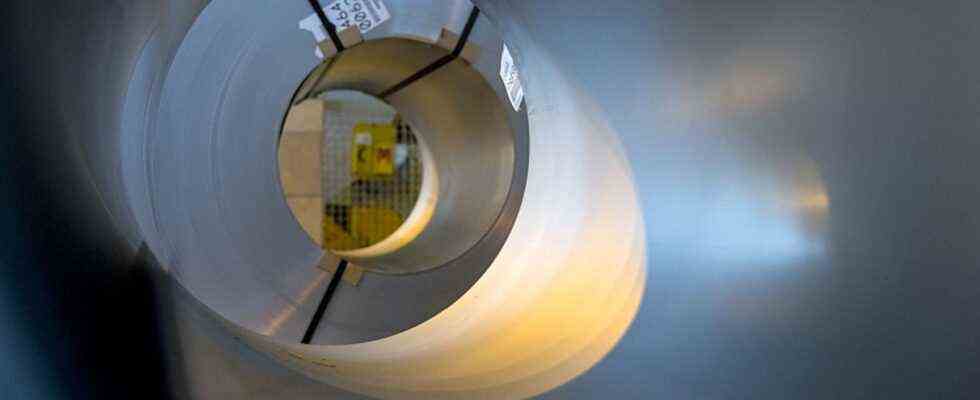Sustainability in the automotive industry
The backpack is getting smaller
A lot of CO2 is emitted in steel production
© press-inform – the press office
The CO2 balance of an automobile is increasingly becoming the decisive control variable in production. However, despite all the good intentions, there is still a lack of implementation of the climate-neutral production chain.
In the religious dispute about the sustainability of electromobility, the question of the “CO2 rucksack” that an electromobile carries around with it is always an issue. The package is mainly filled by the high level of CO2 used in the production of the automobile, especially the battery. The Swedish-Chinese car manufacturer Volvo has dedicated itself entirely to electric cars: From 2030 the Swedes will only sell electric cars. But so that the drive change does not lead to a misfire, the much-vaunted transformation has to permeate all areas of the car, including production and life after the last kilometer.
Now Volvo has taken a close look at the CO2 footprint of the crossover coupé C40 Recharge and has found that from 110,000 kilometers at the latest, the Stromer draws level with a conventionally powered XC40 in terms of CO2 balance. A global energy mix was taken as the basis; if you only rely on wind energy, the threshold drops to 49,000 kilometers. The entire Volvo value chain is to be climate-neutral by 2040. On the way to this environmentally friendly production, the Scandinavians have overcome the first hurdle. At the main plant in Torslanda, Sweden, vehicles have been rolling off the production line in a climate-neutral way since May of this year.
The German automotive industry is also trying everything to put on an ecological vest. Herbert Diess is at the forefront with his tweets, but also the competition from Munich and Stuttgart-Untertürkheim hardly lets a week go by without notifying a message about which sustainability projects are being initiated. Some things almost seem like anticipatory obedience with which one wants to fulfill the supposedly prevailing zeitgeist. Ideas like Mercedes Sustaineer, which cleans the air and collects fine dust particles while driving, are currently little more than technological finger exercises, which should clearly signal: “Look, we’re on the ecological ball.”
VW’s good intentions; BMW & Co. are undeniable. But what about the implementation? In the article “Sustainability in the German automotive industry. How will OEMs and suppliers react to the sustainability megatrend in 2021?” the experts at the Deloitte consultancy come to the conclusion that there is still a lot to do before the climate-neutral land of milk and honey becomes a reality: “For example in decarbonisation, in the development of holistic strategies and in the area of financing.” One topic that needs improvement is the entire value chain. “Only 51 percent of those surveyed look at suppliers in addition to their own company in their sustainability initiatives. And only 40 percent can demonstrate a comprehensive end-to-end approach that includes both the upstream and the downstream supply chain Take the recycling aspect as an example, “the study continues.
Battery recycling is high on the agenda of OEMs for the sheer will to survive. China’s hunger for rare earths and other raw materials will not diminish in the next few years. The other big issue is reducing carbon dioxide in the production of cars. Due to its particularly energy-intensive production, steel production is one of the main causes of global CO2 emissions. “We are leveraging the CO2-intensive production steps”; promises Volvo’s sustainability officer Stuart Templar. So that these words are followed up with deeds, the Swedes have brought SSAB, the largest Scandinavian steel producer, on board with us to produce the metal without fossil fuels.
What is right for Volvo, BMW is only cheap. From 2025, the Munich-based company wants to purchase steel, the production of which causes up to 95 percent less CO2 emissions and does not require fossil raw materials such as coal and has therefore agreed a cooperation with the Swedish start-up H2 Green Steel, which is for steel production, hydrogen and exclusively Green electricity from renewable energies used. “Our goal is to reduce the CO2 emissions in our steel supply chain by around two million tons by 2030. The purchase of steel, which is produced with hydrogen and green electricity, makes a significant contribution to this,” explains BMW Board Member for Purchasing Dr. Andreas Wendt. The BMW approach is not going it alone. Steel giants like Thyssenkrupp are already working on the implementation of the idea. The use of one ton of green hydrogen in steel production saves 26 tons of CO2 compared to the classic blast furnace route. “Steel is indispensable in automobile production and will not lose its importance for future vehicle generations either. Innovative technologies that enable almost CO2-free production of steel have a significant influence on the reduction of CO2 emissions in our steel supply chain,” says Andreas Wendt.


